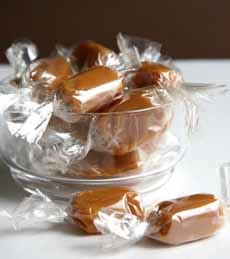
 Artisan caramels are the most buttery, flavorful bites you can imagine. Photo courtesy EH Caramels.
Artisan caramels are the most buttery, flavorful bites you can imagine. Photo courtesy EH Caramels.
|
KAREN HOCHMAN is Editorial Director of THE NIBBLE.
|
|
July 2007
Updated March 2017
|
 |
Crazy For Caramels
Gourmet Caramel Candy From Top Artisans
CAPSULE REPORT: We’d like to nominate old-fashioned caramels as the new hot candy. From the classic perfection of Mrs. Call’s to the heat of Cowgirl Chocolates’ Buckin’ Hot Habañero Caramels to the modern flavor infusions of Cocoa Designs, we love every one of these six winners. A thoughtful house gift instead of wine or flowers, caramels don’t melt in the summer heat. But, they taste great with a cappuccino or a hot chocolate on the coldest winter day. This is Page 1 of a four-page article. Click on the black links below to visit other pages.
What Is Caramel
Caramel is simply sugar, melted into a syrup and cooked until the sugar crystals turn into a dark amber liquid. In this form, it can be used to coat nuts (pralines) and popcorn, thickened into a sauce and a myriad of other delights. Whisk in some butter, remove from the heat and whisk in cream, and you have a delicious caramel sauce. Cook those ingredients to what is known as the “firm ball” stage (245°F, 118°C), and you get buttery, chewy caramel candy,* that can be enjoyed by the piece or combined with chocolate bars and other confections. Keep cooking the caramel to the “hard-crack” stage (290°F, 143°C) and you’ll get crunchy toffee.† Pour the caramel into a pan, scored it into rectangles, and cut and wrap each piece individually to prevent sticking. Then, try not to eat them all at once.
Quality caramels are made with sugar and brown sugar, butter and heavy cream, and flavorings (vanilla, salt and other flavorings—chocolate, maple, coffee, and as you’ll see below, other imaginative choices). In modern candy-making, two other key ingredients are added to the caramel recipe for longer shelf life: corn syrup to present crystallization and lecithin as an emulsifier (a stabilizer, so the ingredients don’t separate). Some caramel makers still wrap their caramels in waxed paper, although others have updated to clear cellophane, a prettier solution that enables customers to see the product.
_____________
*Candy makers use the term “short” to describe a caramel that is too soft (perhaps too moist), and “long” for a caramel that on the chewy side.
†Most toffee is made with butter but not cream; however, a creamier style of toffee, known as cream toffee, adds cream or sweetened condensed milk for a richer toffee.
The History Of Caramel
The word caramel was first recorded in the English language in 1725; it comes from the Spanish caramelo. The original Spanish word did not refer to the chewy caramel candy we know today, but more likely, to caramelized sugar. The source of caramelo is unknown, but some scholars believe it is related to the late Latin calamellus, a diminutive form of calamus, reed or cane—an implied reference to sugar cane.
We know that soft caramel candy is an American invention—we just don’t know exactly when it was invented. By about 1650, Americans were boiling water and sugar in deep kettles in their fireplaces to make hard candies. Someone, at some point, added butter and milk to the pot and invented the caramel. By the mid-1800s, there were nearly 400 American candy manufacturers producing hard candies as well as caramels—recipes for caramels abound in cookbooks of the era. Milton Hershey’s first business was the Lancaster Caramel Company: He learned to make chocolate when seeking a coating for his caramels.†
†Source: Madehow.com, Volume 6: Caramel.
While the British invented toffee, the “soft toffee,” or caramel, invented by Americans crossed the pond in the 1880s, soon enough creating a universal demand in England. Unfortunately, mass-producers cut corners, substituting coconut oil for the butter and cream until, as one writer of the time reported, “competition stepped in with the usual result—the prices lowered, the quality suffered, until anything cut into the shape were called caramels....The very name has almost become a synonym for rubbish.”‡
More than one hundred and twenty-five years later, one might say that most Americans have never tasted a real caramel—only “rubbish” from the supermarket, the newsstand, and mass-merchandise stores. We’re happy to be able to turn back the hands of time, by introducing you to products that taste as good as—or better than—the ones made by artisans of generations past.
_____________
‡Skuse’s Complete Confectioner, [W.J.Bush & Co.:London] 189? (p. 60-61).
Continue To Page 2: Our Favorite Caramels
Go To The Article Index Above

|




